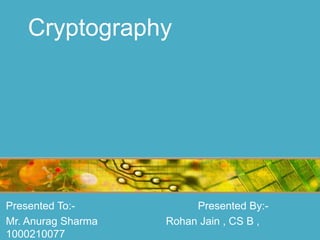
Cryptography
- 1. Cryptography Presented To:- Presented By:- Mr. Anurag Sharma Rohan Jain , CS B , 1000210077
- 2. Overview • Cryptography………………..……….An introduction • Objectives………………………………….Brief Aspect • Terminology……………..…..To Make You Familiar • How………………….…………………….Demonstration • Methods………………………….......Public & Private • Implementation………………..Hashing Algorithm • Cryptography in Networking Security………....… • Applications……………………………Real Life Scope
- 3. Introduction The Word Cryptology is made up of “Kryptos", which means hidden and “Logos" which means word. In Laymen Words, it is an Art and science of protecting data. Technically, It involves logical transformation of information. The Principles of Cryptography are today applied to the encryption of fax ,television, and computer network communications and many other fields. Since the secure exchange of computer data is of great importance to banking, government, and commercial communications as well as for individuals.
- 4. Objectives 1)Confidentiality :-The information cannot be understood by anyone for whom it was unintended. 2) Integrity :-The information cannot be altered in storage or transit between sender and intended receiver without the alteration being detected. (Data Is Not Corrupted). 3)Non-repudiation :-The creator/sender of the information cannot deny at a later stage his or her intentions in the creation or transmission of the information. 4) Authentication :-The sender and receiver can confirm each other’s identity and the origin/destination of the information. (Source Of Data IS Genuine).
- 5. Terminology R O H A N J A I N Plain Text(Can Be Variable Length) Encryption Using Key Using Algorithms (MD4,MD5,SHA-1,RSA) Cipher Text 00 B8 3c Ef G0 Xh 99 3d 2f Using Algorithm (Same As Decryption Using Same Used To Encrypt the Text) Keys R O H A N J A I N
- 6. HOW…?? A Simple Demonstration:-Substitution Cipher To Encode:-> S E C R E T Key :-> Offset the 3rd letter so the alphabets begin with it. So starting with:- ABCDEFGHIJKLMNOPQRSTUVWXYZ and sliding everything by 3, we get:- DEFGHIJKLMNOPQRSTUVWXYZABC So D=A, E=B, F=C…..and so on. Encoded:-> V H F U H W To Decode:-> Provide anyone the key i.e., =>Offset the 3rd letter so the alphabets begin with it.
- 7. Cryptography Methods : Modern Cryptography o Symmetric-Key Cryptography. o Asymmetric-Key Cryptography. o Cryptanalysis.
- 8. Private(Symmetric) Cryptography In symmetric-key encryption each end already has a secret key (code) that it can use to encrypt a packet of information before it is sent over the network to another computer.
- 9. Private Cryptography Methods:- DES (Data Encryption Standard) AES(Advanced Encryption Standard) Older Newer Breakable Unbreakable Smaller Key (56-bit Encryption). Bigger Key(128/192bit /256 bit Encryption). 7*10^16 Key Combinations. 3*10^35 Key Combinations. Smaller Block Size (64 bits). Larger Block Size (128bits). For DES with 64 bits, the maximum amount For AES with 128 bits, the maximum of data that can be transferred with a single amount of data that can be transferred encryption key is 32GB. with a single encryption key is 256 EB.
- 10. Public/Asymmetric Cryptography Asymmetric/Public encryption uses two different keys at once i.e., combination of a private key and a public key. The private key is known only to your computer while the public key is given by your computer to any computer that wants to communicate securely with it. To decode an encrypted Message a computer must use the public key provided by originating computer, and its own private key
- 11. Cryptanalysis The Study of methods to break Cryptosystems. Often targeted at obtaining a key. Cryptanalysis Attacks:- o Brute force o Trying all key values in the keyspace. o Frequency Analysis o Guess values based on frequency of occurrence. o Dictionary Attack o Find plaintext based on common words.
- 12. Implementation of Encryption Keys :Hash Function A hash function is any algorithm or subroutine that maps large data sets of variable length to smaller data sets of a fixed length. For example, a person's name, having a variable length, could be hashed to a single integer. Basic Idea:- Input Number 10,667 Hashing Function Input# x 143 Hash Value 1,525,381 Public keys generally use more complex algorithms and very large hash values for encrypting, including 40-bit or even 128- bit numbers. A 128-bit number has a possible 2128.
- 13. • The values returned by a hash function are called hash values, hash codes, digest ,hash sums, checksums or simply hashes. • A Cryptographic hash function (specifically, SHA-1) at work. Note that even small changes in the source input (here in the word "over") drastically change the resulting output. V U
- 14. Cryptography in Networking Transport Layer Security (TLS) and its predecessor, Secure Sockets Layer (SSL), are cryptographic protocols that provide communication security over the Internet. Several versions of the protocols are in widespread use in applications such as web browsing, electronic mail, Internet faxing, instant messaging and voice-over-IP (VoIP). When you're accessing sensitive information, such as an online bank account or a payment transfer service like PayPal or Google Checkout.
- 15. The client request the SSL connection by sending the request. Server provides it’s secure certificate to client to show it’s authenticity. Client validates the certificate and request a one time session with server. Server completes the SSL handshake and the session begins.
- 16. Applications • ATM Cards • E-Commerce • Computer Passwords • Electronic Fund Transfer • Digital Signatures • Network Security • Storage Integrity
- 17. References http://en.wikipedia.org/wiki/Cryptography http://en.wikipedia.org/wiki/Cryptographic_hash function http://computer.howstuffworks.com/encryption.ht m http://en.wikipedia.org/wiki/Secure_Sockets_Layer
- 18. Queries ??